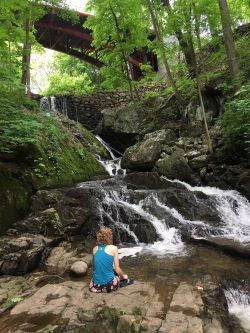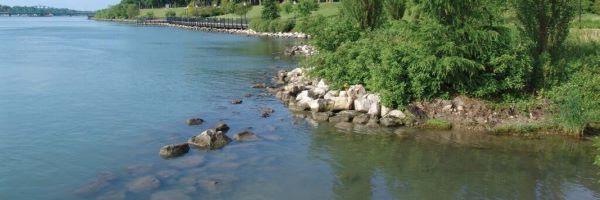In This Issue
- Protecting Headwater Streams Webinars Begin Nov. 3: Register
- Sustainable Shorelines Webinar Oct. 29: Building Resilience in a Changing World
- Funding Available for Water Infrastructure Upgrades
Protecting Headwater Streams Webinar Series Begins November 3rd
 DEC’s Hudson River Estuary Program and Hudsonia Ltd. are offering a 3-part webinar series dedicated to the values, identification, and protection of our small headwater streams. The webinars will take place on Wednesdays, November 3, 10, and 17 from 3 p.m. – 4:45 p.m. Presenters include Gretchen Stevens, Hudsonia Ltd.; Beth Roessler and Nate Nardi-Cyrus, DEC's Hudson River Estuary Program and Cornell University; Emily Vail, Hudson River Watershed Alliance; Emily Svenson, Gordon and Svenson LLP, and Max Garfinkle, Town of Philipstown. DEC’s Hudson River Estuary Program and Hudsonia Ltd. are offering a 3-part webinar series dedicated to the values, identification, and protection of our small headwater streams. The webinars will take place on Wednesdays, November 3, 10, and 17 from 3 p.m. – 4:45 p.m. Presenters include Gretchen Stevens, Hudsonia Ltd.; Beth Roessler and Nate Nardi-Cyrus, DEC's Hudson River Estuary Program and Cornell University; Emily Vail, Hudson River Watershed Alliance; Emily Svenson, Gordon and Svenson LLP, and Max Garfinkle, Town of Philipstown.
Headwater Streams: Values and Threats: Wednesday, November 3, 3 p.m. - 4:45 p.m.
In the first session of this webinar series, our presenters will discuss the physical components, benefits of, and threats to intermittent and perennial headwater streams. Additional topics will include a discussion of vegetated streamside buffers and an introduction to basic protection methods. Register for the 11/3 webinar here.
Headwater Streams: Mapping and Planning: Wednesday, November 10, 3:00 - 4:45 p.m.
In the second session of this webinar series, our presenters demonstrate how to use online resources to identify mapped headwater streams and how to analyze topographic maps and aerial photos to find unmapped streams. We will walk through examples of map analysis to predict the occurrence of streams and discuss how newly identified streams can be incorporated into local conservation planning. There will also be a presentation exploring the role of headwater streams in densely developed cities and villages. Register for the 11/10 webinar here.
Headwater Streams: Protection: Wednesday, November 17, 3:00 - 4:45 p.m.
In the third session of this webinar series, our presenters will discuss state and federal regulatory protections for streams, the potential for local regulations, how to address stream issues in environmental reviews of land development projects, and approaches for crafting and adopting local laws and zoning for wetland protection. The session will end with a case study of a local stream protection law. Register for the 11/17 webinar here.
Building Resilience in a Changing World: Webinar Oct. 29, 2:00 - 3:30 p.m.
This webinar showcases strategies for incorporating climate change adaptation into the management of our coasts and waterways. The program expands upon our previous Sustainable Shorelines webinar, adding to the toolbox of resiliency guidelines available to designers, practitioners, and community decision-makers. All are welcome whether or not you have attended any of the previous webinars. Register for the 10/29 webinar here. For more information on estuary training programs, please visit the Hudson River National Estuarine Research Reserve website.

Funding Available for Water Infrastructure Upgrades
$400 million is available for critical drinking water and wastewater infrastructure upgrades through the Water Infrastructure Improvement Act and the Intermunicipal Water Infrastructure Grants Program. Information and application documents are available on the Environmental Facilities Corporation's website. If you have questions, e-mail NYSWaterGrants@efc.ny.gov or call 518-402-6924.

|


 DEC’s Hudson River Estuary Program and Hudsonia Ltd. are offering a 3-part webinar series dedicated to the values, identification, and protection of our small headwater streams. The webinars will take place on Wednesdays, November 3, 10, and 17 from 3 p.m. – 4:45 p.m. Presenters include Gretchen Stevens, Hudsonia Ltd.; Beth Roessler and Nate Nardi-Cyrus, DEC's Hudson River Estuary Program and Cornell University; Emily Vail, Hudson River Watershed Alliance; Emily Svenson, Gordon and Svenson LLP, and Max Garfinkle, Town of Philipstown.
DEC’s Hudson River Estuary Program and Hudsonia Ltd. are offering a 3-part webinar series dedicated to the values, identification, and protection of our small headwater streams. The webinars will take place on Wednesdays, November 3, 10, and 17 from 3 p.m. – 4:45 p.m. Presenters include Gretchen Stevens, Hudsonia Ltd.; Beth Roessler and Nate Nardi-Cyrus, DEC's Hudson River Estuary Program and Cornell University; Emily Vail, Hudson River Watershed Alliance; Emily Svenson, Gordon and Svenson LLP, and Max Garfinkle, Town of Philipstown.
